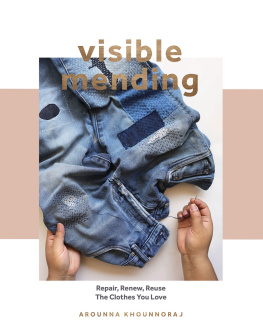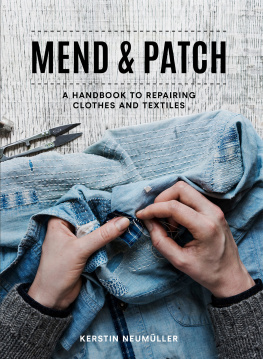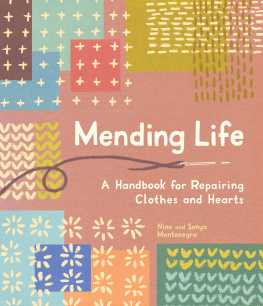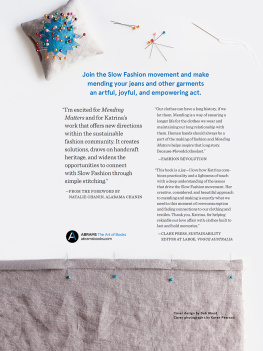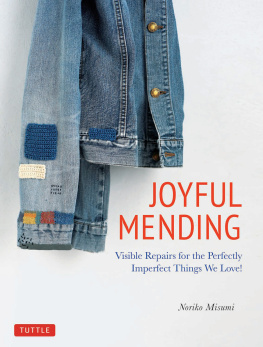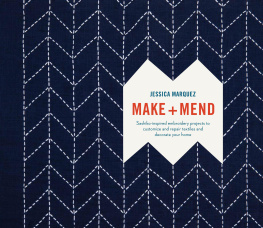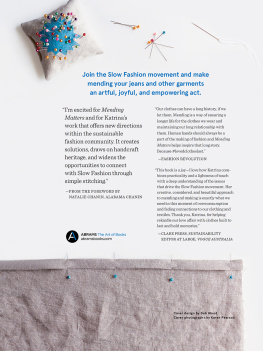The Joys of Mending
Hello! I believe this may be the first time weve met.
When putting together this book with the theme of mending, I patched up
many peoples clothing and memories. That is, I had happy moments where
I felt like I was traveling through everyones memories with my needle and
thread in my hands. A stain that wouldnt come out. An inadvertently-made
hole.
I purposefully did not fix all of those things. That is because I wanted to
mend them in a way that reflected the people who wore or used those pieces,
and their reasons for wanting to keep them. I like this color combination.
Its so comfortable I cant throw it away.
While remembering these fond remarks I thought, I wonder if it would
please them if I did it this way, and put my feelings into the mending. Its
similar to choosing a gift.
Im not able to teach the magical techniques for making something look
completely new again, but Id like to introduce the kind of mending that lets
symbolic pieces evoke happy memories and a sense of pleasure in the passing
of time. Its a simple idea, but if its something that will add a spark to your life,
then Ill be very happy.
Noriko Misumi
Why I Wrote This Book
I think its good to enjoy unexpected encounters of receiving new items
while also mending and treasuring the old.
A mother who likes dressmaking and a father
who carries around his toolbox and fixes
everything himself. Having been raised by
parents like these, it was completely natural for
me to make things. The first thing I made was a
felt pin cushion. Even now I use it and treasure it.
Ive liked sewing since I was a child, but in
college, majoring in textiles, I learned about
various other aspects such as design and dying
and weaving. After graduating, I attended a two
week summer art program in the U. S. There, I
specialized in mixed media. It was perfect for
me. I think the creations I made from mixing
techniques and materials back then form a
connection to what I do and how I live now.
After that, I worked at making art for
commercials and creating models for museums
for about two years, with the plan of going on a
journey once I had saved enough money, but in
an unexpected turn of events I joined a company
that developed a lifestyle brand and started a job
making displays.
Even now as a freelancer, I still continue to
make displays. The job of creating displays that
suggest new spaces, one after another, while
incorporating the feel of seasons and trends
is always fresh and fun. But no matter how
beautifully you create it, its not meant to last
forever.
I have always had deep-rooted desire to
treasure things long-term, and spend time on
small tasks, to make things of lasting beauty,
even while Im making ephemeral things, like
displaysthings that are like a passing dream.
I treasure the old while receiving the new.
I think that type of balance is necessary.
Mending
is Love
Sketches of mending ideas that
came to mind while thinking
of the items owner. Sketching
helps me organize my mind,
and new ideas can also pop up.
PROFILE Noriko Misumi
Designed window displays at Zazabi
after graduating from the textile
program in the Department of
Industrial, Interior and Craft Design
at Musashino Art University. Is now
independent and engages in a wide
variety of projects, such as store
displays and styling for magazines
and publications. She projects
decorating ideas and the joy of
handcrafted items.
My Favorite Things
Sashiko dishcloths made by grandma
Dishcloths with colorful stitches inherited from
my husbands grandmother on his mothers side,
which she made in a nursing home during her final
years. I remember the way she shaped each sashiko
stitch so carefully, and treasure these cloths as I use
them now.
Thread and cloths dyed in natural colors
Thread and cloth dyed with vegetable dyes, which
were made from the liquid from boiling beans or
onion skins. You can also dye natural colors using
coffee or tea. The yellow tinting of clothes or stains
can also be concealed with vegetable dyes.
Mini spools of thread of leftover thread
Leftover thread, stored by wrapping the thread
around a wooden clothespin, with the end of the
thread securely held in place. Its neat without
being bulky, and easy to find the end of the thread
the next time I use it.
Haphazard knitted piece
Made by randomly knitting with leftover yarn I
couldnt throw away. If one yarn ran out, even in
mid-motif, I continued with another. I enjoy the
haphazard pattern that resulted.
Cross-shaped needle case
A cutout in the shape of a cross from a wool vest
I stopped wearing. Becomes a needle case when
the flaps are folded in and held with a marking
pin. It was makeshift, but its so easy to use that I
frequently use it as is.
Letter from friend in another country
A letter from a Swedish friend who is an up-and-coming
designer, accompanied by a yo-yo quilt and fabric
scraps. Overflowing with feelings of fondness for little
things and love for fabrics.
Colorful waste thread
The leftover thread on the end of a needle from
embroidery, stored in a tin. Thats alljust thread
I should throw away, but mysteriously seems so
dear to me. Used when I want to do just a little
embroidery.
Dust cloth with freestyle embroidery
Dust cloth made by my husbands grandmother in
her final years. Apparently she was skilled in both
Japanese dressmaking and Western dressmaking
in her youth, but I like this freestyle expression. I
feel the warmth of her handiwork.
My Philosophy of Mending and Life
If the thread runs out, I continue with a different
colored thread. If I dont have any new fabric,
I take and use some from a shirt or blouse I no
longer wear. Of course I also use new fabric, but
skillfully using the items near to hand, without
overdoing it, like the yarn of a sweater Ive
undone, or fabric I dyed when I was a college
studentI think that is the joy of mending.
Time spent mending will feel special if you
add some simple stitches freely; theres no need to
follow a model or example exactly.
Even stains from spills when eating and holes
from getting caught on something may have some
kind of meaning. The reason I started thinking
this way is that the lid of a special teapot I received
from a friend as a wedding gift broke because
of my carelessness, and I had it repaired with a
lacquer mixed with gold by someone I trusted.
That kind of mending, called kintsugi , is a truly
beautiful art, and Ive come to love my teapot even
more after it was broken.
Items with unintentionally-created stains
and holes may be chances for us to come to like
something even more than before. As with my
teapot repaired with gold, I think its good to enjoy
those chance encounters through mending.

![Noriko Misumi [ミスミノリコ] Mending with Love: Creative Repairs for Your Favorite Things](/uploads/posts/book/306555/thumbs/noriko-misumi-mending-with.jpg)


